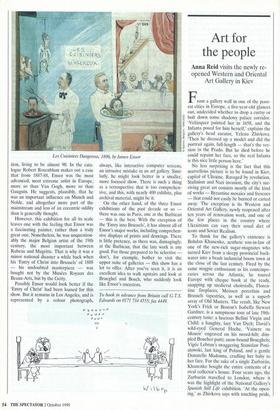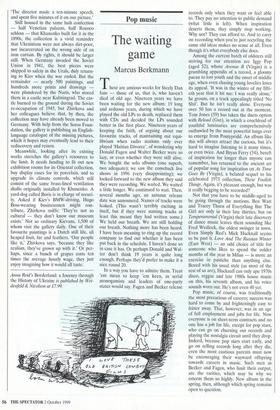Art for the people
Anna Reid visits the newly re- opened Western and Oriental Art Gallery in Kiev From a gallery wall in one of the poor- est cities in Europe, a five-year-old glances out, undecided whether to drop a curtsy or bolt down some shadowy palace corridor. 'Velazquez painted her in 1658, and the Infanta posed for him herself,' explains the gallery's head curator, Yelena Zhivkova. 'Then he dressed up a model and did the portrait again, full-length — that's the ver- sion in the Prado. But he died before he could repaint her face, so the real Infanta is this nice little person here.'
No less surprising is the fact that this marvellous picture is to be found in Kiev, capital of Ukraine. Ravaged by revolution, Stalinism and Nazi invasion, the city's sur- viving great art consists mostly of the kind of works — Byzantine mosaics and frescoes — that could not easily be burned or carted away. The exception is its Western and Oriental Art Gallery, newly reopened after ten years of renovation work, and one of the few places in the country where Ukrainians can vary their usual diet of icons and Soviet Realism.
To thank for the gallery's existence is Bohdan Khanenko, aesthete son-in-law of one of the new-rich sugar-magnates who turned Kiev from a sleepy provincial back- water into a brash industrial boom town at the close of the last century. Fired by the same magpie enthusiasm as his contempo- raries across the Atlantic, he toured Europe with cheque book at the ready, snapping up medieval choirstalls, Floren- tine fireplaces, Meissen porcelain and Brussels tapestries, as well as a superb array of Old Masters. The result, like New York's Frick or Boston's Isabella Stewart Gardner, is a sumptuous tour of late 19th- century taste: a luscious Bellini Virgin and Child; a haughty, lacy Van Dyck; David's wild-eyed General Hoche, `Vaincre ou Mourir' engraved on his sword-hilt; dim- pled Boucher putti; snow-bound Brueghels; Vigee Lebrun's swaggering Stanislaw Poni- atowski, last king of Poland, and a gentle Donatello Madonna, cradling her baby to her face. For the sake of a single Zurbaran, Khanenko bought the entire contents of a rival collector's house. Four years ago, the Zurbaran travelled to London, where it was the highlight of the National Gallery's Spanish Still Lift exhibition. 'At the open- ing,' as Zhivkova says with touching pride,
The director made a ten-minute speech, and spent five minutes of it on our picture.'
Still housed in the same lush confection — half Venetian palazzo, half Rococo schloss — that Khanenko built for it in the 1890s, the collection is a vivid reminder that Ukrainians were not always dirt-poor, nor incarcerated on the wrong side of an iron curtain. By rights, it should be larger still. When Germany invaded the Soviet Union in 1941, the best pieces were shipped to safety in the Urals, duly return- ing to Kiev when the war ended. But the remainder — nearly 500 paintings, and hundreds more prints and drawings — were plundered by the Nazis, who stored them in a castle near Kaliningrad. The cas- tle burned to the ground during the Soviet re-occupation of 1945, but Zhivkova and her colleagues believe that, by then, the collection may have already been moved to Germany. With help from the Soros Foun- dation, the gallery is publishing an English- language catalogue of the missing pictures, which it hopes may eventually lead to their rediscovery and return.
Meanwhile, looking after its existing works stretches the gallery's resources to the limit. It needs funding to fit out new exhibition rooms for its Oriental collection, buy display cases for its porcelain, and to upgrade its climate controls, which still consist of the same brass-lined ventilation shafts originally installed by Khanenko. A yard-dog called Boris is in charge of securi- ty. Asked if Kiev's BMW-driving, Hugo Boss-wearing businessmen might con- tribute, Zhivkova sniffs: 'They're not so cultural — they don't know our museum exists.' Not so ordinary Kievans, 1,500 of whom visit the gallery daily. One of their favourite paintings is a Dutch still life, all heaped fruit, fur and feathers. 'Our people like it,' Zhivkova says, 'because they like realism, they've grown up with it.' Or per- haps, since a bunch of grapes costs ten times the average hourly wage, they just enjoy imagining how it would all taste.
Anna Reid's Borderland: a Journey through the History of Ukraine is published by Wei- denfeld & Nicolson at £7.99.











































































 Previous page
Previous page